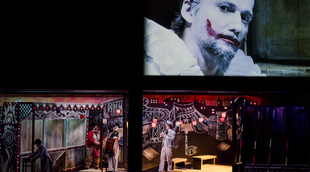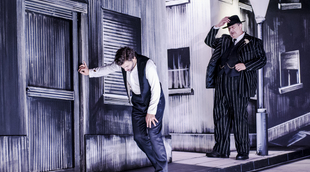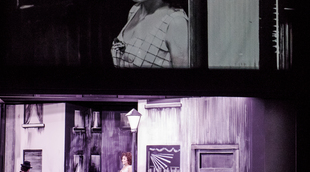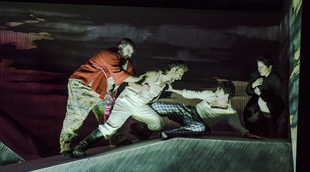 © DR
© DR
Perhaps not as well known as some more regularly staged operas, Cavalleria Rusticana and Pagliacci (by Mascagni and Leoncavallo, respectively) are, nonetheless, major operas in the history of the genre (laying the foundations of verismo), with some of the most famous arias in opera and, in particular, having been interpreted by the greatest singers (Caruso foremost among them). And more recently, by Jonas Kaufmann, reprising the role of Turiddu at the Salzburg Easter Festival next 28 March. It would be a shame to miss this opportunity to review in greater detail the history of these two works that are so representative of the lyric art.
***

“Cav and Pag” is how opera lovers have referred to the two twin works that are emblematic of verismo, Cavalleria Rusticana and Pagliacci, ever since the Metropolitan Opera in New York took the initiative to present them together one evening in 1895 because each of them by itself was too short to fill up an evening. This pairing, no other example of which exists, has become almost systematic, even though it is not the result of any concerted strategy on the part of the two composers, Mascagni and Leoncavallo. Yet beyond the contingencies associated with a performance, almost everything seemed to point to “Cav and Pag” becoming inseparable siblings in the lyric repertoire. Composed just two years apart, these two dramas of jealousy show obvious similarities in construction and style. They are set in the South, land of rustic peasants unyielding on points of honour. And they are most of all the spearhead of an attempt to breathe new life into the lyric genre, the “musical verismo” that finds its origins in late 19th century Italian literature. With Cavalleria Rusticana and Pagliacci, opera is endowed with a new dramatic dimension: it becomes the expression of a “slice of life” far removed from the noble subjects provided by history, mythology and tragedy. Singing becomes the way to reveal all the torment of passion in a sort of “natural” lyric madness whose outburst will have the power of “lived” emotion. By entering the domain of “realism”, verist opera opens up the Pandora’s box of the concept of realism and comes up against the difficult attempt to reconcile the natural and the true in a work of art. Verismo falls immediately into ambiguity. Is opera a world of convention par excellence? Shouldn’t precise fidelity to reality start by eliminating singing, a means of expression that clashes with realism in a world subjected to the passions and violence of an implacable code of honour?
A Happy Convergence of Circumstances
“Mascagni got his start as a verist more by accident than through ethical conviction,” as we are reminded quite rightly by Scotch musicologist David Kimbell in his work on Italian opera. At the recommendation of Giacomo Puccini, his friend and former co-student at the Milan Conservatory, Pietro Mascagni (1863-1945) decided to participate in the competition organised in 1888 by Milanese publisher Edoardo Sonzogno, a great rival of the famous publishing house Ricordi and owner of the Teatro Lirico. This was the second edition of this initiative intended to promote the careers of new talents among young Italian composers. Mascagni saw this as a unique opportunity to get beyond the anonymity he experienced in his life as a professor in Cerignola, a small town in Puglia where he spent time after debuting as orchestra conductor in a travelling company specialising in operettas. He wanted to compose a one-act opera in keeping with the finest Italian tradition without ignoring the new perspectives of the lyric art. A vast undertaking, whose difficulties Mascagni understood well, having witnessed the failure of his friend Puccini, who presented Le Villi when the competition was established in 1883.

After asking his friend, poet Giovanni Targioni-Tozzeti, to write a libretto, Mascagni took his advice and chose to put to music a play by Giovanni Verga, Cavalleria Rusticana, which he had seen in Milan in 1884 and dreamed of making an opera out of it. Once he had the final version of the libretto put together by Targiono-Tozzeti with help from another poet-friend, Guido Menasci, Mascagni set about with youthful enthusiasm working to exhaustion, spending sixteen to eighteen hours a day composing! In just two months the composer completed what would become his sole masterpiece. The reward for this feverish inspiration, whose passion we find again in the work’s movement and in the writing of the score, which the jury liked, was a huge success. This was a stunning win, as he beat out another competitor who also had a promising future, Umberto Giordano (1867-1948), the future composer of Andrea Chénier (1896). At the end of the first performance on 17 May 1890, the happy composer of Cavalleria Rusticana was called back to the stage of the Teatro Costanzi in Rome sixty times, accepting the ovations of an audience gone wild, as he recounted in a letter to his father: “I still haven’t recovered from my emotion and all that upheaval.I never could have imagined such enthusiasm (…) Everyone in the orchestra was standing, all the ladies, even the Queen, clapping their hands (…). I signed a contract with Sonzogno that will bring in 12 to 15,000 lire for me in two-and-a-half years. I won the first prize. My situation is completely transformed.” Cavalleria Rusticana very quickly began taking over stages worldwide, in Madrid, Munich, Buenos-Aires, Vienna, Paris, New York… Not to mention the many Italian productions. Every opera house wanted to produce Cavalleria Rusticana, and all the greatest conductors and singers did their best to distinguish themselves: Caruso, Del Monaco, Domingo, Emmy Destin, Rosa Ponselle, Maria Callas and Grace Bumbry…. Over the years following this prodigious success, Mascagni did experience other successes, including in particular L’Amico Fritz (1891), but the composer was to remain a one-masterpiece composer.
Birth of a Brother, Almost a Twin
History likes to repeat itself, but always with variations. Two years after Cavalleria Rusticana debuted triumphantly, the famous publisher Sonzogno again took on the role of good fairy, transforming the career of a young composer impatient to make himself known. The difficult early days and the sudden recognition of Ruggero Leoncavallo (1857-1919) are uniquely reminiscent of Pietro Mascagni’s career. As the accompanist for singers in Paris’s cafés-concerts, where he became friends with Jules Massenet, who was then a singing coach, Leoncavallo was having difficulty living off his art. He immediately found an example to follow in Mascagni’s success: (…) After the success of Mascagni’s Cavalleria Rusticana,I lost patience and, convinced that Ricordi the publisher would never do anything for me, I shut myself in at home, desperate but determined to wage one final battle, and in five months I wrote the libretto and the music for this Pagliaccio that the publisher Sonzogno bought from me after simply reading the libretto.” It might be added that before going to Sonzogno, Leoncavallo had proposed Pagliacci for the new edition of the competition that had given Mascagni his triumph. Unfortunately the rules required that an opera be composed in a single act, and Pagliacci had two. On 21 May 1892, the work was staged at the Teatro dal Verme in Milan under the baton of a then-unknown orchestra conductor, Arturo Toscanini. It was a triumph. By the end of the year, Gustav Mahler was in Budapest conducting this violent drama dominated by jealousy. After Cavalleria Rusticana, Pagliacci set off to conquer all the world’s greatest stages. All the most famous singers lent their talents to the main protagonist, Canio, which became Caruso’s favourite role. On 4 January 1895, the twin works were performed one after the other on the stage of the Metropolitan Opera. This was the official birth of “Cav and Pag”.There were many other attempted combinations.Cavalleria Rusticana was sometimes associated with Puccini’s Il Tabarro, but nothing could undo the fraternal bonds between these two works, bearers of new inspirations in Italian lyric art in the late 19th century. Opera needed to be reinvented after Verdi’s unshared reign, and Wagner’s crushing presence. Opera abandoned the places of power and the symbolic world of mythology to pursue the rough paths of peasant life.
Putting “a Slice of Life” to Music

Although Cavalleria Rusticana appeared as the first verist opera, it was only two years later that the real manifesto for this new style was clearly stated in the famous Prologue to Pagliacci, added by the composer at the request of celebrated baritone Victor Maurel (1848-1923), who created the role of Iago in Verdi’s Otello (1887). Considered the finest Verdian baritone of his era, Maurel was immediately enthusiastic upon reading the new work by Leoncavallo, who had become his friend during the Italian musician’s stay in Paris. The singer proposed that the composer create the character of the clown Tonio, suggesting that the role be fleshed out with an additional aria. That would be the famous Prologue that made Leoncavallo the head of this “verist” movement that had established itself with Cavalleria Rusticana. Tonio the humpbacked clown sticks his head out between the closed curtains. He asks the audience for permission to speak in an overture to the drama so as outline the plot and reveal its full scope. Tonio introduces himself as an allegory: “I am the Prologue,” he says. This wink at the processes of 18th century opera may be surprising at the start of a verist work and shows that the composer is unable to make a conventional genre – opera – into a faithful mirror of reality, unlike what Tonio promises when he addresses the audience: “The author sought instead to paint you a slice of life.His only motto is that the artist is a man, and he must write for men. And be inspired by truth.” What is this? We are supposed to be witnessing a “true story” whose protagonists are flesh-and-blood beings. So the composer has no goal other than to put to music the reality of the everyday life of the humblest of people, following the path opened by Italian novelists like Giovanni Verga (1840-1922) and Luigi Capuana (1839-1915), who might have summarised the aesthetic issues of realism like Emile Zola (1840-1902): “It is no longer a matter of inventing a complicated story, a dramatic unlikelihood that astonishes the reader; it is simply a matter of recording human events (…).The first man who happens by is a sufficient hero; examine him, and you will certainly find a simple drama that deals with all the processes of feelings and passions.”
From Peasant Chivalry to the Grimacing Smile of the Acrobat
Cavalleria and Pagliacci are both operas based on simple and violent events set in a harsh region drenched in sunlight, the Mezzogiorno. The unit of time, action and place is scrupulously followed to give the greatest possible relief to the depiction of these dramas that hit the public like a fist in the chest. Cavalleria is an adaptation of a story by Verga, Zola’s friend and admirer. This story, Cavalleria Rusticana, literally “rustic chivalry”, is taken from a collection of stories that appeared in 1880, Vita dei campi. The codes of this “rustic” chivalry are dictated by the strict meaning of “honour” in Sicily. A single act of great dramatic density is enough to tell the tale of a brutal and bloody settling of accounts in a Sicilian village on Easter Day. Bizet had previously paved the way with Carmen (1875), Mascagni’s obvious model. With La Traviata (1853), Verdi decided to tell the story of the fall of a “depraved” woman, an anti-heroine whose tragic fate was written in the reality of her times, and hence in the reality of the man in the street. Mascagni thus goes all out in this search for realism, to which he adds a regionalist dimension. Sicily and its implacable code of honour make their entry into opera with this peasant tragedy in which passion faces off against the desire for vengeance heightened by the violence of jealousy.

Reprising the same system of very tight dramatic construction, but this time in two acts, Pagliacci also exploits a news headline. We leave behind the sombre Sicilian peasants for Calabria and a troupe of travelling actors. Leoncavallo’s own father had been called upon to judge an affair of murder occurring on stage during a performance in Montalto Uffugo, a village in Calabria. However, the Pagliacci libretto shows no similarities with that news story. The main source of Leoncavallo’s inspiration is probably to be found quite simply in the world of opera itself, where the theme of murderous jealousy was very much in fashion. It is difficult for an artist to pledge complete allegiance to a “slice of life” reality. Yet in Le Figaro on 9 June 1899, Leoncavallo went so far as to reveal that his hero was still alive, and that after his release from prison he entered the service of a Calabrese baroness. He provided these clarifications to undermine the suit for plagiarism he was being threatened with by writer Catulle Mendès, who accused him of having plagiarised his story, La Femme de Tabarin. However that may be, the theme of the desperate clown who must make the audience laugh while he is suffering cruelly is also a traditional theme often used by authors. Hence the question can legitimately be asked: does verismo exist other than as a claim? Is turning an opera into a people’s portrait a way to approach what is real, or is it simply a way to explore new horizons in order to breathe new life into opera? Claude Debussy believed that Cavalleria was not life but rather a “deceit”. But how can opera, an art of convention if ever there was one, be life in the strict meaning of the word? But while Mascagni goes to the bother of scattering folkloric dances and themes throughout his score, and even if he includes in his verist drama religious scenes with a typically Sicilian atmosphere, we are more into local colour than the reconstruction of actual events. That is why we can hardly be surprised at what Mascagni said in 1910: “Verism murders music; only poetry, romanticism can give wings to inspiration.”
If we look more closely, we find that operas grouped together under the broad label of versim are no more faithful to the truth than other works. We can find no ideological purpose in Mascagni. His peasants sing in chorus about love and flowers, and we are very far from the engaging painting made by his model, Giovanni Verga. The Sicilians in Cavalleria could be confused with any of the villagers inhabiting 18th and early 19th century operas. The main protagonist, Turiddu, conforms to the model of the tenor hero, although in order to heighten the realistic effect, his is given a very lovely aria composed on the theme of a popular song (“O Lola ch’hai di latti “).
Even more paradoxical is the construction of Pagliacci, which is based on the mise-en-abyme process, a crafty game of mirrors that is astonishingly modern, but ultimately not very “realistic”. The work’s originality perhaps lies mostly in this alliance between an unusual dramatic violence and the often-used technique of the “play within a play”. Canio and his wife Nedda, itinerant actors who will perform the drama of Harlequin and Colombine for the public in a little village in Calabria, until reality suddenly shifts the performance into the horror of murder. In his Harlequin costume, Canio, the betrayed husband made mad with jealousy, kills his wife Nedda who is playing Colombine and her lover Silvio who tries to come to her rescue. “La commedia è finita!” concludes the murderer-husband in response to the shrieks of horror from the spectators, who suddenly realise that the red blood flowing is quite real and the actors are not “pretending”.
Music and Truth
The musical language of verists has often been considered a facile lyricism based on crude processes. It is true that there is no shortage of intense moments intended to arouse the audience’s emotions in their works. Leoncavallo took the utmost care in preparing the libretto for Pagliacci in order to match text and music and achieve the greatest possible emotional force. The spectator/listener must be overwhelmed by the music, which follows the psychological changes in the characters, making it easy to identify with them. The audience must also be transported into a simple world re-created in rich and evocative orchestral writing, like that of the intermezzos present in both of these operas.
Doesn’t the power of Cavalleria and Pagliacci come primarily from the ability of their authors to create strong, theatrically effective roles, which has always been an attractive experience for the singers? The heightening of everyday reality enables the versists to present new characters who cannot leave the artists indifferent, making them want to incarnate flesh-and-blood beings in direct contact with the audience. All the great names in opera contributed to the formidable success of both Mascagni and Leoncavallo; the gradual disappearance of the pairing “Cav and Pag” has to do no doubt with the lack – one would hope temporary – of performers up to the vocal challenges hidden within the extreme dramatic tension of these dramas. Pagliacci includes one of the most famous arias in all Italian opera, the famous “Vesti la giubba” in which Canio gives himself over to despair at having to overcome pangs of jealousy in order to present a smiling, reassuring face to the public while he feels a burning desire to kill. The vocal writing in Cavalleria is constantly driven by passion, and the spoken word is used whenever it is necessary to translate the feverishness and irrepressible power of the feelings, as in the paroxysmal shriek on which this miniature opera ends: “Hanno ammazzato compare Turridu!” (“They have killed Turridu!”).
In April 1939, a young singer interpreted her first complete role at the Olympia Theatre in Athens. It was Maria Callas singing Santuzza. The musical director, George Karakantas, said: “She may not have completely mastered her voice, but her interpretation of ‘Voi lo sapete’and the ‘Easter Hymn’had such a dramatic impact that the imperfections were forgotten.” It seems a matter of fate that Maria Callas, who revolutionised the art of singing and stagecraft, took her first steps playing the impetuous and passionate Santuzza. Victor Maurel, the creator of Tonio in Pagliacci, had created Iago and Falstaff. He was one of the first singers to concern himself with analysing his characters in order to better incarnate them through his expressive acting. Using the characteristics of his extraordinary voice, Caruso made Canio his signature role, trying to achieve realism in theatrical expression. While verist opera takes us close to a truth, it is first and foremost the truth of the artist, who, with his dramatic temperament and vocal capacity, can keep all the promises of a score marked by fervour and the youth of its two authors, Mascagni and Leoncavallo.
Catherine Duault
the 25 of March, 2015 | Print



Comments